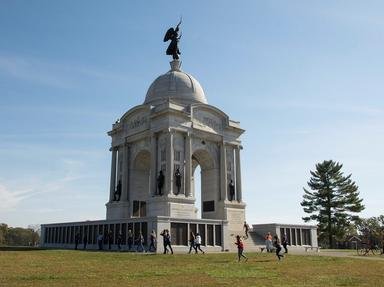Quiz Answer Key and Fun Facts
1. The Confederate Army of Northern Virginia, on the march to Gettysburg in the summer of 1863, had been restructured in the wake of General Thomas "Stonewall" Jackson's recent death. Which sickly general commanded the newly formed Third Corps at Gettysburg?
2. Shortly after the Confederate Army of Northern Virginia began its march north, Major General Joseph Hooker, the commander of the Army of the Potomac, resigned. His place was taken by Fifth Corps commander George Gordon Meade. Who replaced Meade in command of the Fifth Corps?
3. On July 1, the first day of the Battle of Gettysburg, General John Buford, commanding two brigades of cavalry, held off an entire Confederate division, thus preserving the high ground around the Lutheran Seminary for Union use. Which of the following was a colonel under Buford's command?
4. Many officers on both sides were killed or wounded during the Battle of Gettysburg, but for some a different fate was in store. This Confederate Brigadier General (the commander of the Third Brigade of Henry Heth's Division) was captured on the July 1 and spent time at Fort Delaware military prison.
5. At the end of the first day's fighting, the Union Army had been forced into a retreat, but still held the high ground south of the city of Gettysburg. The shape of the Union line famously formed a "fish hook." The Twelfth Corps, posted on Culp's Hill, formed the "hook" of this line. Who commanded the Twelfth Corps?
6. On July 2, 1863, this commander of the Union Third Corps made a decision which has since been criticized by most historians. Seeking higher ground than that which he had been ordered to defend, he advanced his corps forward, creating a dangerous bulge in the Union line. This general's name was _________.
7. General Robert E. Lee's most trusted lieutenant at the Battle of Gettysburg was Lt. General James Longstreet. Longstreet was, overall, rather critical of Lee's plans throughout the battle. Along much of the line, Longstreet's men carried the fighting on the second day. Which of Longstreet's leading men was killed on the second day?
8. This Union leader from the Second Corps had a custom of going into battle wearing a bandanna. He was killed in the Wheatfield on July 2.
9. On July 3, 1863, Lt. General Robert E. Lee ordered one division of Longstreet's corps, together with two brigades from A. P. Hill's corps, to advance on the center of the Union line atop Cemetery Ridge. This advance, though leading to the "High Water Mark of the Confederacy," proved catastrophic for the Confederate army. The advance became known as Pickett's Charge, named for the divisional commander whose troops were involved. Which of these men was not a brigade commander under the command of George Pickett?
10. One of the reasons that the Confederate army fared so badly on July 3 was that their men were subjected to enfilade fire from the batteries on Cemetery Hill to the north and Big Round Top to the south. "Enfilade fire" means that the artillery is able to fire into the flanks of the line rather than the front, thus maximizing casualties. This man was General Meade's chief of artillery and the organizer of the Union artillery on July 3.
Source: Author
Portuman
This quiz was reviewed by FunTrivia editor
bloomsby before going online.
Any errors found in FunTrivia content are routinely corrected through our feedback system.
